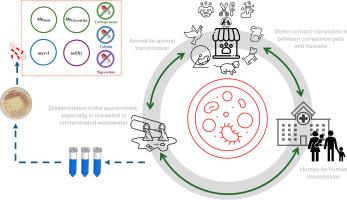肺炎克雷伯菌ST14共携带blaNDM-1、blaOXA-232、mcr-1.1和一种新型IncI1 tet(X4)质粒,并有证据表明ColKP3在抗生素压力下可动员
IF 5.8
Q1 MICROBIOLOGY
引用次数: 0
摘要
伴侣动物和环境生态位是抗菌素耐药性(AMR)基因的相互关联的储存库,促进了它们在宿主和生态系统之间的持久性和水平转移。在连接人类、动物和环境健康的“同一个健康”框架内,与宠物有关的环境仍然是抗生素耐药性传播的一个未得到充分认识的来源。宠物美容设施从动物皮肤、粪便和受污染的表面产生含有细菌的废水,可能成为促进环境污染和人畜共患病传播的因素。在这里,我们描述了从泰国曼谷宠物美容设施的废水中分离出的广泛耐药肺炎克雷伯菌菌株的完整基因组特征。全基因组测序鉴定该分离物为序列型(ST) 14,这是一种全球传播的与多药耐药和临床暴发相关的高风险克隆。该菌株携带4个具有临床意义的耐药基因,分别位于不同的质粒上,分别为blaNDM-1、blaOXA-232、mcr-1.1和tet(X4)。据我们所知,这是肺炎克雷伯菌ST14中首次报告tet(X4)。该基因是在一个新型的inci1型质粒上发现的,该质粒上有一个复合转座子,表明该基因是最近通过水平基因转移获得的。偶联实验证实了高转移效率和表型替加环素耐药性。在本研究中,虽然blaOXA-232被携带在非共轭colkp3型质粒上,但粘菌素的选择促进了它的转移,质粒大小扩大,表明抗生素驱动的动员。这些发现强调了肺炎克雷伯菌ST14的进化适应性以及宠物相关废水作为临床重要抗菌素耐药性基因储存库所带来的风险。迫切需要综合基因组监测和有针对性的“同一个健康”干预措施,以防止环境和人畜共患病传播。本文章由计算机程序翻译,如有差异,请以英文原文为准。

Emergence of Klebsiella pneumoniae ST14 co-harboring blaNDM-1, blaOXA-232, mcr-1.1, and a novel IncI1 tet(X4) plasmid, with evidence of ColKP3 mobilization under antibiotic pressure
Companion animals and environmental niches act as interconnected reservoirs of antimicrobial resistance (AMR) genes, facilitating their persistence and horizontal transfer across hosts and ecosystems. Pet-associated environments, within the One Health framework linking human, animal, and environmental health, remain an underrecognized source of AMR dissemination. Pet grooming facilities generate wastewater containing bacteria from animal skin, fecal matter, and contaminated surfaces, potentially acting as factors that facilitate environmental contamination and zoonotic transmission. Here, we describe the isolation and complete genomic characterization of an extensively drug-resistant Klebsiella pneumoniae strain from wastewater at a pet grooming facility in Bangkok, Thailand. Whole-genome sequencing identified the isolate as sequence type (ST) 14, a globally disseminated high-risk clone associated with multidrug resistance and clinical outbreaks. The strain harbored four clinically significant resistance genes, blaNDM-1, blaOXA-232, mcr-1.1, and tet(X4), each located on distinct plasmids. To our knowledge, this is the first report of tet(X4) in K. pneumoniae ST14. The gene was found on a novel IncI1-type plasmid with a composite transposon, suggesting recent acquisition through horizontal gene transfer. Conjugation assays confirmed high transfer efficiency and phenotypic tigecycline resistance. In this study, although blaOXA-232 was carried on a non-conjugative ColKP3-type plasmid, colistin selection facilitated its transfer with plasmid size expansion, indicating antibiotic-driven mobilization. These findings highlight the evolutionary adaptability of K. pneumoniae ST14 and the risk posed by pet-associated wastewater as a reservoir for clinically important AMR genes. Integrated genomic surveillance and targeted One Health interventions are urgently needed to prevent environmental and zoonotic spread.
求助全文
通过发布文献求助,成功后即可免费获取论文全文。
去求助
来源期刊

Current Research in Microbial Sciences
Immunology and Microbiology-Immunology and Microbiology (miscellaneous)
CiteScore
7.90
自引率
0.00%
发文量
81
审稿时长
66 days
 求助内容:
求助内容: 应助结果提醒方式:
应助结果提醒方式:


